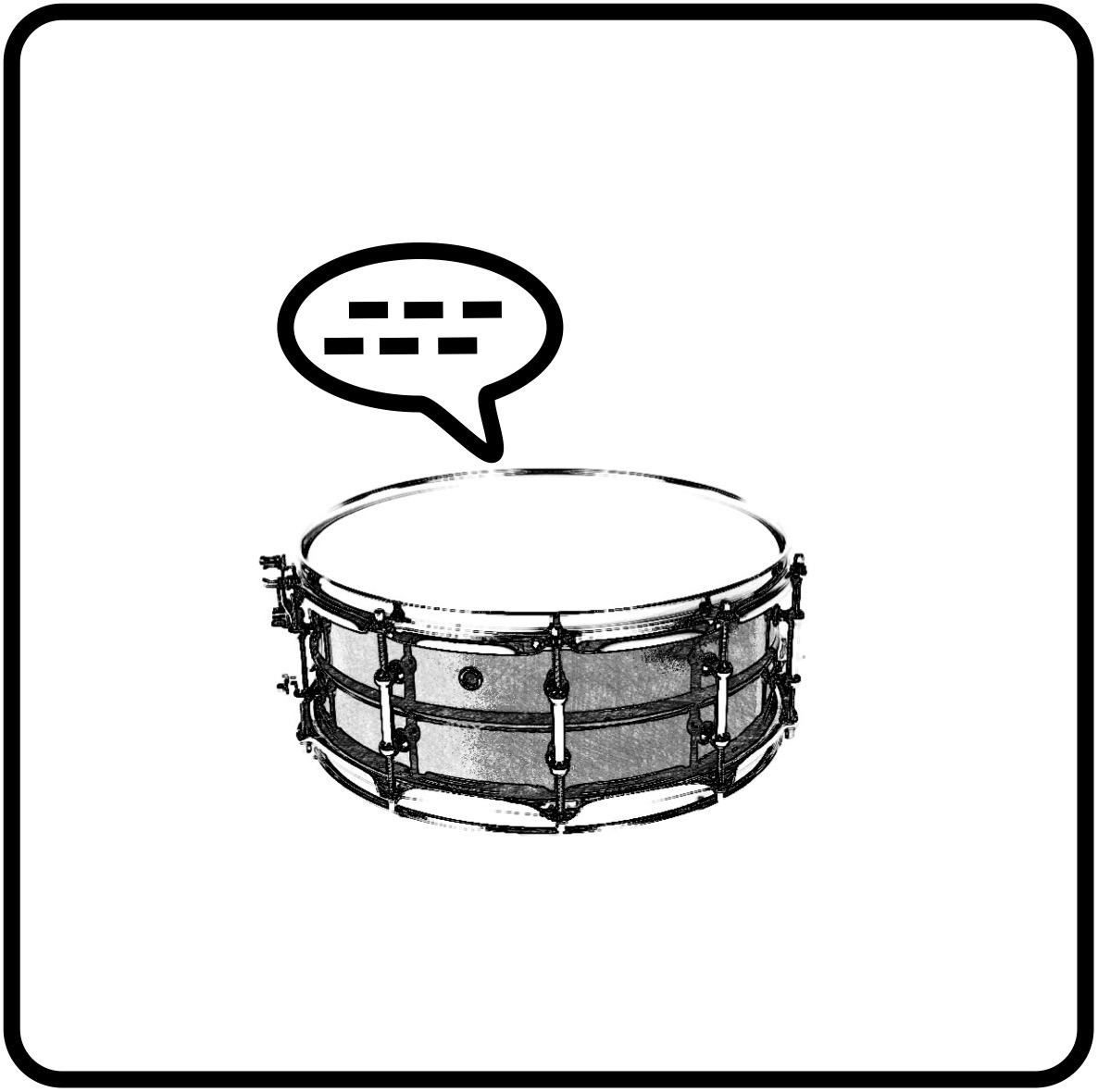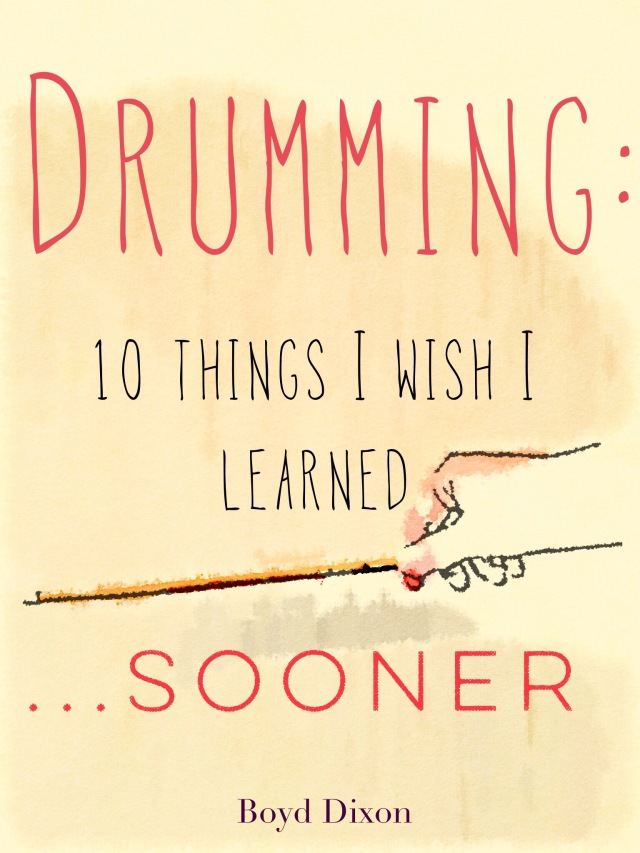For all those who have read my book “Drumming: 10 Things I Wish I Learned…Sooner” I want to say thank you for all your support. I read every review. Over the past few months, I’ve received many requests for more material. However, if I release a new book, I want to make sure that it delivers exactly what my audience wants. So, if you have a minute, please leave me a comment and let me know if you would like a second book, and if so, let me know who I can make it the perfect book for you. Thanks again to all of you for a great 6 months!
Drum Meds #26-Note Placement
One often overlooked aspect of sounding good on drums is the deliberate placement of notes. There are several common situations where people misplace notes, and the overall effect is that they sound less “solid.”
Make sure that when two notes are supposed to hit at the same time, that they hit EXACTLY together. This is not as easy as it sounds.
Be aware of the note spacing between 8th notes. Sometimes, when drummers play straight 8ths on the hihat, they use the shank-tip technique. However, sometimes the unaccented note is not placed directly on the upbeat and it sounds sloppy.
When playing the common jazz ride cymbal beat, sometimes drummers focus only on landing the 2 & 4 correctly, and ignore the 3rd note of the beat, which lands on 1 & 3. This makes it difficult for the band to find a groove.
Drummy Tip #25-Practicing With Headphones
If you can, try running all your audio through a speaker instead of headphones. When your click or play-along track is blaring through headphones, it is very difficult to listen to yourself playing. Alternatively, you could mic your drums and run that along with your audio to your headphones. If you are used to practicing with an ultra-clear, loud bass track, you may be unprepared for real world gigging, where your mix is vastly different from room to room. Years back, I experienced this with my teacher. I went in to play with a play along track, and I could not hear the bass player no matter how high he turned up the track, because he was running through a speaker, not headphones.
Likes and subscribes are always appreciated!
Drummy Tip #24-How To Make $500/Week Playing Drums
I did this all through college, and you certainly can too. First, your skill needs to be at a level that people are willing to pay for. Once your skill is there, arrange your week this way:
Sunday- church gig—-$100
Monday-Thursday- minimum 4 students——————-$200 @ $50 each
Friday-Sunday- at least two nights of cover gig——————–$200
=$500
How do you get church gigs and cover band gigs? Churches usually advertise on Craigslist, and most won’t pay. Keep checking, and if you find a church that doesn’t specify whether it pays or not, assume it does pay and ask how much, after your audition. If they ask why you should be paid, when they have members of the congregation who will play for free, explain that you are being paid for the convenience of them not having to spend hours to teach the drummer every song, because you come to church ready to perform. See my Drummy Tip on Charting for help on that.
How do you get cover band gigs? Well, you can find mediocre cover bands advertising in craigslist, and they will pay. The best cover bands hire people they know. That means you need to go to their shows, buy them a drink, chat, and be social. Get to know them on breaks. The minimum payment you should accept for any performance is $100.
How do you get students? First, I don’t feel anyone should teach an instrument unless they have had extensive lessons themselves, from a reputable teacher. When you take lessons, you also are learning how to give lessons. To get students, you need to invest a little money in nice flyers and take them to music stores. You need to make relationships with the employees at the music stores. Sit down at the kit at the store and show them a couple things you think they will like. Also call the schools in your area and ask to speak with the band director, and ask them if you could meet with them about your private lessons program. Some schools will pay you to give lessons at the school. Just those things should be able to get you at least 4 students.
Couple extra things-
1. Always pay your taxes.
2. You can’t make money being shy.
Thank You
A quick post here, just wanted to say thanks for the huge number of people who have downloaded my book so far, and especially for the wonderful reviews! It makes me very happy to hear how my book has helped or inspired you.
-Lets Talk Drums
I’m always here
Drummy Tip #23-What You’re Really Paid For
This Drummy Tip is for drummers who make their living performing.
What you’re paid for-
1. Loading gear, and helping others in the band unload their gear.
2. Knowing the songs beforehand. You aren’t paid for showing up to rehearsals, you’re paid for your expertise in being able to learn a song quickly and supplying the right groove the first time you play it.
3. Making the band sound good. You aren’t paid for flexing your drum muscles, you’re paid because you make everyone on the bandstand feel great.
4. Keeping the band on the same page. The band often looks to you for cues to the next section, and sometimes they will literally turn around and watch you to see when you cue them. In those situations, you need to make it obvious with a clear sounding fill. This means you need to be aware when a band member is trying to communicate with you, which means you can’t just stare at the drums all night. Some drummers, including myself, will wear a headset with a microphone, and verbally cue the whole band into each section.
5. Putting on a show. No one goes to a show to see musicians in their own heads, staring off into space in deep focus. If you put out an energetic vibe, the band will do the same, and the audience will dig it. Remember, many people hear with their eyes.
If you loved this Drummy Tip, read my Ebook on Amazon!
Free Book Redux
Drummy Tip #22-Snare Drum Stuff
Here are a few things about snare drums that are good to know.
1. It is usually a good idea to tune the bottom head tightly, because that will allow for the best snare response. Imagine you have a set of marbles. Drop the marbles on a tile floor. Now drop them on carpet. The difference you see there is the same difference you get with a tight bottom head versus a loose one.
2. Pay particular attention to the the tension rods adjacent to the snare wires. Those tension rods have the greatest impact on the snare response.
3. If you have a wooden drum, and its overtones are too pronounced, you can roughen the inside of the drum with course sandpaper and that will reduce the overtones. Obviously, this is a drastic measure and irreversible so only do this if you are certain! You can also reduce the overtones by changing the hoop on the top of the drum. A die cast or wooden hoop will produce less overtones. The smoothness on the inside of the drum and the type of hoop have a large effect on overtones.
4. Many people dislike the ringy sound that some drums produce, and they remedy this by covering the drum with duct tape and napkins. If that produces the sound you want, then go for it! But keep in mind that how you play the drum also affects the overtones. If you hit the drum in the dead center, you will eliminate a lot of that ring. Take a quarter and a marker and put the quarter in the middle of the drum, and trace a circle on the drum around the quarter. If you hit the drum in that circle, the ringing will be minimal.
5. A word on snare tension – if you play very softly at the edge of the drum, and you don’t hear any snare response (it sounds like a tom) then your snares are too tight. Your drum should produce a snare response at all volumes if the snares are on.
Drummy Tip #21-Instantly Improve Your Fills
There are three things you can do to drastically improve your fills.
1. Make your fill a reorchestration or variation on the groove of the song. In other words, take the groove you’re playing, play it on another part of the kit, and your fill will make sense to anyone who hears it. Or if the fIll leads to another section (which it should, but I’ll talk about that in another post) orchestrate the next groove into your fill.
2.Play your fill at the exact same dynamic marking as your groove, unless the song has a crescendo or decrescendo, or you’re moving into another dynamic marking. If you play your fill strikingly louder than the groove, and then go back to your original volume, it sounds out of place.
3. Incorporate your cymbals. If you’re playing the cymbals as part of your groove, and then you completely stop playing them to play a fill, it takes away from the momentum of the groove. Sometimes you can play fills that way, but most of the time if you incorporate the cymbals, it will keep the groove strong.
If you loved this Drummy Tip, check out my book on Amazon!
Drummy Tip #20-Drumming Mistakes
Have you ever been in this scenario? You go to the snare drum to perform a piece for your teacher. Several bars in, you make a mistake and stop. The teacher tells you not to stop under any circumstances, and you try again. You make a mistake, and almost inadvertently, you stop AGAIN. You keep stopping even though you don’t mean to.
This happens because that is how you practiced it. You played until you messed up, and then stopped. Here’s how to fix it.
When you practice an exercise or a piece, and you make a mistake, improvise a drum part until you get your bearings and can pick it back up. For instance, say you miss the inverted flam tap on bar 3. Play anything, perhaps 8th notes or flams, anything, and try to get back to the piece by bar 5. Try to get to where you only have to improvise one measure to get back on your feet. Then, when you are done, you can go back and work the measure that tripped you up by itself.
This is so important, because you will make mistakes in performances. Dave Weckl does, Buddy Rich did, everyone. The reason you don’t know about it is because they are experts at covering their mistakes by continuing to make music. Even when you are reading a piece of music, it is better to make up a measure or two than to stop.
Don’t forget to read my book! It has 10 must-learn principles that many people won’t tell you.













